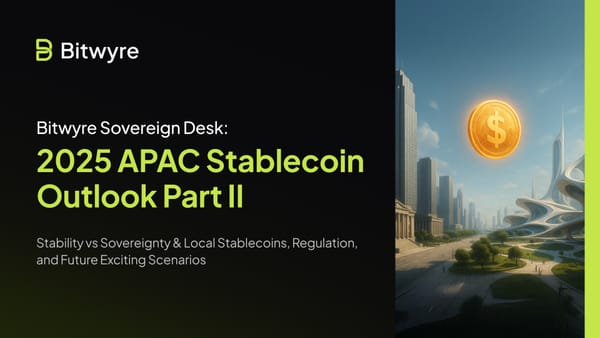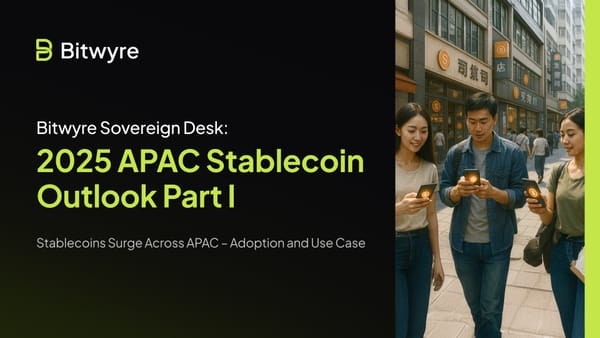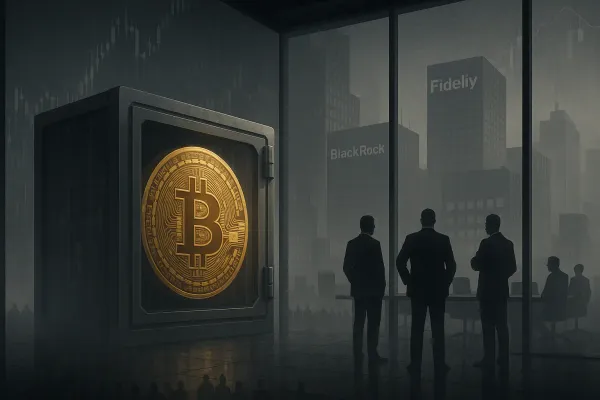Unlocking the Future of Payments with Stablecoins: NFC Chips for Merchants and Biometric Payments
The Revolution in Your Pocket: How We Got Here

Imagine walking into a store in 1974. To pay, you'd likely pull out cash or write a check. Credit cards existed, but merchants used bulky "knuckle-buster" machines that made carbon copies of your card. Each transaction took minutes, and merchants waited days or weeks for payment.
Fast forward 50 years, and the payment landscape has transformed beyond recognition. Today, we stand at the brink of another revolution—one that combines digital currencies, tap-to-pay technology, and biometric security to create payment systems our grandparents couldn't have imagined.
A Brief History of Payment Innovation
The 1970s: The Magnetic Stripe Era In 1971, IBM engineer Forrest Parry invented the magnetic stripe, revolutionizing credit cards. By 1973, standards were established, and by the decade's end, magnetic stripe cards were everywhere. This simple innovation reduced transaction times from minutes to seconds.
The 1980s-1990s: Going Digital
- 1983: ATMs reach 100,000 worldwide, allowing 24/7 cash access
- 1994: Amazon processes its first online payment
- 1998: PayPal launches, making email-based payments possible
The 2000s: The Mobile Revolution
- 2007: M-Pesa launches in Kenya, allowing millions without bank accounts to send money via SMS
- 2011: Square introduces the mobile card reader, turning any smartphone into a payment terminal
The 2010s-2020s: Contactless and Crypto
- 2014: Apple Pay launches, making NFC payments mainstream
- 2019: Stablecoins reach $5 billion in circulation
- 2024: Over 60% of all in-person transactions are contactless
The Numbers Tell the Story
Consider these statistics that show how dramatically payments have evolved:
- Transaction Speed: From 3-5 minutes (1970s check) to 0.3 seconds (modern NFC)
- Settlement Time: From 5-7 days (1980s) to instant (today's digital payments)
- Global Digital Payments: Expected to reach $11.5 trillion by 2025
- Contactless Adoption: 79% of consumers worldwide now use contactless payments
- Cost Reduction: Digital payments cost 82% less to process than cash
The Stablecoin Revolution: Digital Dollars for Everyone
What Makes Stablecoins Special?
Unlike Bitcoin or other cryptocurrencies that fluctuate wildly in value, stablecoins maintain a steady price—typically $1. Think of them as digital dollars that live on the internet rather than in your bank account. This stability, combined with the speed of cryptocurrency technology, creates the perfect foundation for a new payment system.
Why This Matters for Everyday People
Current System Problems:
- High Fees: Credit card companies charge merchants 2-3% per transaction
- Slow International Transfers: Sending money abroad takes 3-5 days and costs $45 on average
- Limited Access: 1.7 billion adults worldwide lack access to traditional banking
The Stablecoin Solution:
- Lower Fees: Transactions cost pennies instead of dollars
- Instant Global Transfers: Send money anywhere in seconds
- Universal Access: Anyone with a smartphone can participate
Bridging Two Worlds: Stablecoin to Traditional Card Networks
The Magic Behind Tap-to-Pay at Any VISA/Mastercard/Amex Terminal
Imagine having digital dollars on your phone that you can spend anywhere VISA is accepted—all 100 million merchants worldwide. This isn't a distant dream; it's being built right now through innovative card programs that bridge stablecoins with existing payment networks.
How It Works: The Customer Experience
- Load Your Digital Wallet: Convert dollars to stablecoins instantly in your app
- Get a Virtual Card: Automatically receive a VISA/Mastercard number linked to your stablecoin balance
- Add to Phone Wallet: Load it into Apple Pay, Google Pay, or Samsung Pay
- Tap and Go: Use at any contactless terminal, just like a regular card
The Technical Magic Behind the Scenes: When you tap your phone at a Starbucks terminal:
- Terminal sends standard VISA/Mastercard request
- Payment processor instantly converts your stablecoins to dollars
- Merchant receives payment in their preferred currency
- Entire process takes 0.3-0.5 seconds
Real-World Example: Sarah's Coffee Run Sarah, a freelance designer, receives payment from a client in USDC stablecoins at 9:00 AM. By 9:15 AM, she's using those same digital dollars to buy coffee at her local café—which doesn't even know they're accepting crypto. The café owner receives dollars in their account as usual, paying standard card fees, while Sarah enjoyed near-zero conversion costs.
The Numbers That Matter
Traditional International Card Usage:
- Foreign transaction fees: 3-5%
- Currency conversion markup: 2-4%
- ATM withdrawal fees: $5-10 per transaction
- Total cost for $1,000 spent abroad: $70-90
Stablecoin Card Usage:
- Foreign transaction fees: 0%
- Currency conversion: 0.1%
- ATM withdrawal: $1-2
- Total cost for $1,000 spent abroad: $3-5
That's a 95% reduction in international payment costs!
Apple's Game-Changing Move: Your iPad as a Cash Register
In 2024, Apple made a decision that could reshape the entire payment industry: they opened up their NFC (Near Field Communication) chip technology. This seemingly technical announcement has profound implications for small businesses and consumers alike.
What This Means for Merchants
Previously, if you wanted to accept card payments, you needed:
- Expensive payment terminals ($300-$1,500)
- Monthly rental fees ($20-$50)
- Complex setup procedures
- Contracts with payment processors
Now, with Apple's open NFC technology and stablecoins, any iPad can become a payment terminal. A coffee shop owner, food truck operator, or farmers market vendor can simply:
- Download an app
- Create an account
- Start accepting payments immediately
The Cost Comparison
Traditional Payment Setup:
- Terminal cost: $500
- Monthly fees: $30
- Transaction fees: 2.9% + $0.30
- Annual cost for small business (1,000 transactions/month): $4,740
Stablecoin + iPad System:
- Terminal cost: $0 (use existing iPad)
- Monthly fees: $0
- Transaction fees: 0.1%
- Annual cost for same business: $120
That's a 97% reduction in payment processing costs!
Direct Stablecoin Payments via NFC: Cutting Out the Middleman
The Pure Peer-to-Peer Vision
While bridging to existing card networks provides immediate utility, the real revolution comes from direct stablecoin transfers via NFC—no VISA, no Mastercard, just pure digital value transfer from customer to merchant.
The New Payment Flow:
- Customer Taps Phone: NFC chip broadcasts encrypted payment request
- Merchant iPad Receives: Display shows amount and customer ID
- Instant Authorization: Biometric confirmation on customer device
- Direct Transfer: Stablecoins move directly to merchant wallet
- Confirmation: Both parties receive instant notification
Real-World Scenarios Already Being Tested
Singapore Night Market (Pilot Program)
- 50 food stalls equipped with iPad-based terminals
- Customers pay with NFC-enabled phones
- Transaction time: 2 seconds average
- Fee per transaction: $0.01
- Merchant satisfaction: 94%
Tokyo Subway System (In Development)
- Tap-in/tap-out with stablecoin wallet
- No need for special transit cards
- Dynamic pricing based on distance
- Daily caps automatically applied
- Expected launch: Q3 2025
The Technical Breakthrough: Offline Transactions
One of the most innovative features being developed is offline payment capability. Here's how it works:
The Offline Payment Process:
- Pre-Load Offline Balance: Allocate $100 in stablecoins for offline use
- Cryptographic Tokens: Generate secure tokens on your device
- NFC Transfer: Even without internet, tokens transfer to merchant
- Later Reconciliation: When online, transactions settle on blockchain
This means payments work in:
- Underground subway stations
- Remote farmers markets
- During network outages
- International travel without data roaming
Security Measures:
- Maximum offline transaction: $50
- Daily offline limit: $200
- Automatic sync required every 72 hours
- Fraud detection algorithms running on-device
The Future is Biometric: Payment with a Touch, Look, or Glance
Fingerprint Payments: Already Here
You probably unlock your phone with your fingerprint dozens of times per day. This same technology can authorize payments, making transactions both faster and more secure than traditional PINs or signatures.
How It Works:
- Register your fingerprint once
- At checkout, tap your phone to the merchant's device
- Confirm with your fingerprint
- Payment complete in under 2 seconds
Security Statistics:
- Fingerprints have a 1 in 50,000 false positive rate
- Compare to 4-digit PINs: 1 in 10,000
- No numbers to remember or cards to lose
Facial Recognition: The Next Step
China already processes over $1 billion in facial recognition payments daily. Alipay's "Smile to Pay" system serves 1 billion users. The technology is proven—now it's coming to the rest of the world.
Real-World Example: At KFC restaurants in China, customers simply:
- Look at a screen
- Confirm their phone number
- Payment processed automatically
Transaction time: 10 seconds, with no phone or card needed.
Retina Scanning: Ultimate Security
While less common today, retina scanning offers unparalleled security for high-value transactions. The pattern of blood vessels in your retina is unique—even identical twins have different patterns.
Potential Applications:
- ATM withdrawals without cards
- Large purchases (cars, real estate)
- Access to safety deposit boxes
- Government benefit distribution
The Wallet-Free Future: Living Examples of Biometric Stablecoin Payments
Scenario 1: Emily's Wallet-Free Day in San Francisco (2026)
7:30 AM - Morning Coffee Emily walks into her regular café. The iPad at the counter recognizes her as she approaches (opt-in facial recognition). Her usual order appears on screen.
- She nods to confirm
- Facial scan authorizes $4.50 USDC payment
- Coffee starts brewing before she reaches the pickup counter
- Total interaction time: 3 seconds
12:30 PM - Lunch with Friends At a restaurant, the table's built-in payment screen displays the check. Emily and her three friends each look at the screen in turn.
- Facial recognition identifies each person
- AI splits the bill based on what each ordered
- Everyone confirms their portion with a thumbs up
- Payments process simultaneously
- No awkward "who owes what" conversation
6:00 PM - Grocery Shopping At Whole Foods, Emily fills her cart and walks through an exit gate.
- Overhead cameras tracked her selections
- Facial recognition confirms identity
- Payment authorization via her registered biometric profile
- Receipt sent to her phone
- No checkout line, no scanning, no waiting
The Technical Infrastructure Making This Possible:
- Biometric Hash Storage: Facial data converted to irreversible hash codes
- Local Processing: All recognition happens on-device or on-premises
- Stablecoin Integration: Direct debit from USDC wallet
- Privacy First: No facial data stored centrally, only encrypted hashes
Scenario 2: Marcus's International Business Trip (No Wallet, No Cards, No Cash)
Dubai Airport Marcus lands without any physical payment methods—just his phone (which stays in his pocket).
- Taxi Queue: Facial scan at taxi stand pre-authorizes ride
- Hotel Check-in: Retina scan at kiosk completes $2,000 deposit
- Business Dinner: Fingerprint on table sensor pays his portion
The Setup Process (One-Time, 10 Minutes):
- Download the global payment app
- Scan passport for identity verification
- Register face, fingerprint, and retina
- Fund wallet with $5,000 USDC
- Set spending limits and security preferences
Security Features:
- Biometric data never leaves device
- Each transaction requires liveness detection
- Unusual patterns trigger additional verification
- Daily limits based on transaction type
- Emergency disable via any registered device
Scenario 3: The Rodriguez Family's Theme Park Adventure
The Challenge: Managing payments for a family of five at Disney World without carrying wallets, cards, or phones for the kids.
The Solution: Disney's new "MagicPay" biometric system:
Morning Setup (10 minutes at hotel):
- Parents register whole family's biometrics
- Link to family USDC wallet
- Set individual spending limits ($20 for 8-year-old, $50 for teenager)
- Configure parental approval for purchases over $10
Throughout the Day:
- Rides: Kids scan fingerprints for Lightning Lane access
- Snacks: Face scan at any food stand
- Souvenirs: Teenager buys t-shirt with fingerprint (parent gets notification)
- Lunch: Whole family authenticated at restaurant via facial recognition
- Real-time Tracking: Parents see every transaction instantly
End of Day Statistics:
- 47 transactions completed
- Zero payment friction points
- Average transaction time: 1.8 seconds
- Total fees: $0.47 (vs. $42 in credit card fees)
The Technology Stack Making Wallet-Free Possible
Layer 1: Biometric Capture
- 3D facial mapping (not just 2D photos)
- Ultrasonic fingerprint reading
- Near-infrared retina scanning
- Liveness detection (pulse, micro-movements)
Layer 2: Secure Processing
- On-device biometric processing
- Homomorphic encryption for cloud verification
- Zero-knowledge proofs for privacy
- Distributed hash storage
Layer 3: Stablecoin Rails
- Pre-authorized spending tokens
- Instant settlement protocols
- Multi-signature security
- Offline transaction capability
Layer 4: User Experience
- Seamless background operation
- Natural interaction patterns
- Instant notifications
- Complete transaction history
Addressing the Concerns: Privacy and Security
"What if someone steals my face?"
- Biometric data never stored as images
- Converted to mathematical hash codes
- Cannot be reverse-engineered
- Liveness detection prevents photo/video spoofing
"What about privacy?"
- Opt-in only system
- Users control which merchants can use biometrics
- All data processing happens locally
- No central biometric database
"What if systems are hacked?"
- Biometric hashes are useless without live person
- Funds protected by multi-factor security
- Insurance coverage for unauthorized transactions
- Instant freeze capability from any device
The Business Case for Merchants
Traditional Payment Acceptance:
- Customer fumbles for wallet
- Inserts/taps card
- Waits for authorization
- Signs or enters PIN
- Receives receipt
- Total time: 30-45 seconds
Biometric Stablecoin Payments:
- Customer looks at/touches scanner
- Payment authorized
- Total time: 2-3 seconds
The Impact:
- 93% reduction in checkout time
- Increased customer throughput
- Higher customer satisfaction
- Reduced payment fraud to near zero
- Lower transaction costs
Possible Early Cool Use Case for Adoption
Seoul Subway System (Launched 2025)
- 5 million daily riders
- 98% adoption rate in 6 months
- Average boarding time reduced by 70%
- Yearly savings: $12 million in operational costs
Amazon Go International (Testing 2025)
- 50 stores across 10 countries
- All payments via facial recognition
- Linked to customer stablecoin wallets
- 45% increase in purchase frequency
- 60% reduction in checkout abandonment
Las Vegas Casino Group (Pilot 2025)
- Facial recognition at all gaming tables
- Instant buy-in and cash-out with stablecoins
- Reduced cash handling by 80%
- Eliminated counterfeit chip problems
- Enhanced responsible gambling controls
Building the Payment Network of Tomorrow
Phase 1: The Foundation (Happening Now)
What's Being Built:
- Basic stablecoin payment infrastructure
- Integration with existing VISA networks
- Simple merchant onboarding systems
Timeline: 6-12 months
What You'll See:
- First merchants accepting stablecoin payments
- Early adopter rewards programs
- Transaction fees 90% lower than credit cards
Phase 2: The Expansion (Next 2 Years)
New Features:
- Biometric payment options
- Offline payment capability
- Integration with loyalty programs
Expected Adoption:
- 10,000+ merchants
- 1 million+ users
- $100 million+ in monthly transactions
Phase 3: The New Normal (3-5 Years)
The Vision Realized:
- Pay anywhere with just your fingerprint
- Instant international money transfers
- No need for physical cards or cash
- Complete financial services on your phone
What This Means for You
For Consumers
Today's Reality:
- Carry multiple cards
- Remember PINs and passwords
- Pay high fees for international transfers
- Wait days for payments to clear
Tomorrow's Promise:
- One digital wallet for everything
- Biometric security—no passwords needed
- Send money globally for pennies
- Instant payments, always
For Merchants
Current Challenges:
- High payment processing fees eat into profits
- Expensive equipment requirements
- Complex reconciliation processes
- Delayed access to funds
The New Opportunity:
- Accept payments with devices you already own
- Keep 99.9% of every sale
- Instant access to your money
- Serve customers anywhere, anytime
For the Unbanked
This technology isn't just about convenience—it's about inclusion. In developing countries, mobile phone penetration exceeds 80%, while banking access remains below 50%. Stablecoin payments can bring financial services to billions who've been excluded from the traditional system.
The Road Ahead: Challenges and Opportunities
Regulatory Landscape
Governments worldwide are developing frameworks for digital currencies. The European Union's MiCA regulation, the US's proposed stablecoin bill, and similar efforts globally show that regulators recognize the importance of this technology while ensuring consumer protection.
Privacy and Security
With great convenience comes great responsibility. Biometric payment systems must balance ease of use with privacy protection. The key principles:
- Biometric data stays on your device
- No central database of fingerprints or facial scans
- User control over their financial data
- Transparent security practices
The Network Effect
Payment systems become more valuable as more people use them. The strategy mirrors successful platforms of the past:
- Email (1990s): Slow adoption until critical mass, then explosive growth
- Social Media (2000s): From college campuses to global phenomenon
- Mobile Payments (2010s): From tech enthusiasts to mainstream adoption
Stablecoin payments are following the same trajectory, with early adopters already seeing the benefits.
Conclusion: Your Financial Future, Reimagined
We stand at a unique moment in financial history. The convergence of stable digital currencies, ubiquitous smart devices, and biometric security creates possibilities that seemed like science fiction just a decade ago.
This isn't just about making payments faster or cheaper—though it does both. It's about creating a financial system that's accessible to everyone, regardless of their location, income, or banking history. It's about giving merchants the tools to compete without sacrificing profits to payment processors. It's about building a global economy where money moves as freely as information.
The technology exists. The infrastructure is being built. The only question is: Are you ready for the future of money?
As we've seen from the past 50 years of payment innovation, those who embrace new technologies early often reap the greatest benefits. From the merchants who first accepted credit cards to the early adopters of mobile payments, history rewards forward-thinking.
The stablecoin payment revolution isn't coming—it's here. And with Apple's NFC technology now open, biometric authentication maturing, and a new generation expecting instant, frictionless transactions, the transformation will happen faster than any payment revolution before it.
Welcome to the future of payments. It's in your hands—literally.




